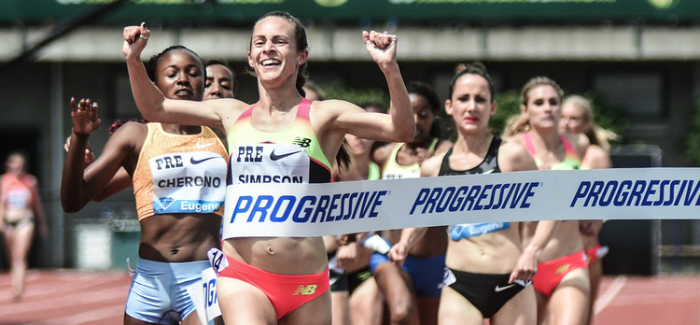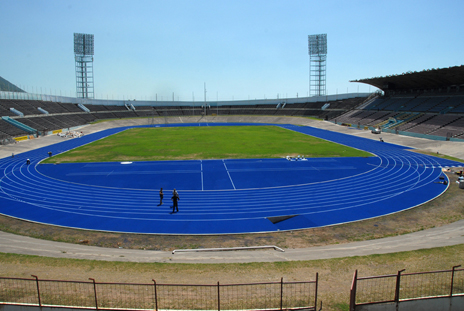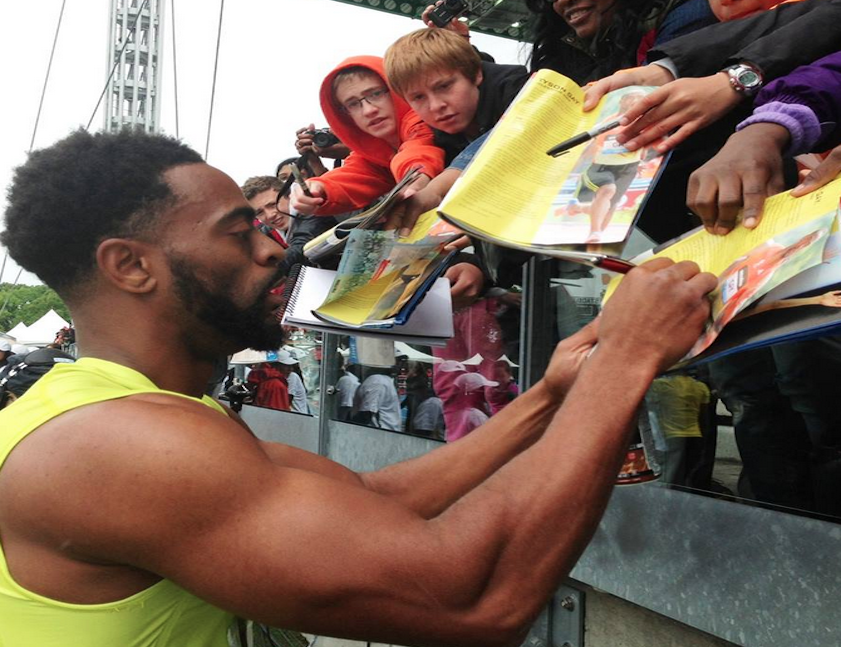The Monday Morning Run: A-Z Guide to the US Championships
Kevin Sully | On 22, Jun 2015
The Diamond League is on sabbatical and last weekend was filled with teenagers running ungodly fast times throughout the country. Recapping that is just going to make you feel slow and me feel weird, so instead we look ahead on this week’s Monday Morning Run. Beginning Thursday, we have the first professional outdoor meet with real stakes since the 2013 World Championships. Here is part 1 of the A-Z Guide to this week’s US Championships in Eugene.
A-Standard
There is no A and B anymore only The Standard. The qualifying process as a whole has been simplified to fill the fields at World Championships. The IAAF will use a descending order list, which means in the running events at least, you are safe to assume that the first three across the line are on the team for Beijing (excluding byes and scratches).
The good news is you don’t need to memorize who has what time and what the qualifying marks are for the men’s 1,500 anymore. You don’t need to write down the 2As + 1B formula on your hand before the meet begins. There is no more “the guy in third hasn’t run fast enough and neither has the person in fourth so actually the fifth place runner is on the team if the other two runners don’t…….”
It means that you can, at least for this season, move “B Standard” and “Chasing the Standard” out of the terminology of track and field and instead use them in their proper place–as perfectly adequate indie band names. Victory for all!
Byes
Here is the list of athletes who have a free pass to the World Championships by virtue of being a Diamond League champion or defending world champion. If you see them hanging out by the snack bar 10 minutes before they are supposed to race, you know why.
Lashawn Merritt- 400
David Oliver- 110H
Ashton Eaton- Decathlon
Brianna Rollins- 100H
Brittany Reese- Long jump
Justin Gatlin- 100
Michael Tinsley- 400H
Christian Taylor- Triple jump
Reese Hoffa- Shot put
Allyson Felix- 200
Jenny Simpson- 1500
Consider them ghost runners (or ghost throwers/jumpers) and remember that they don’t occupy one of the US’s three spots for the World Championships. That is, unless, the athlete is competing in an event where they don’t have a bye. Justin Gatlin still needs a top three finish in the 200 if he wants to go for the double in Beijing. Same with Allyson Felix in the 400.
Though it takes away some of the drama of the meet, I’m a fan of the bye. It incentivizes “regular season” success and also helps to add more quality runners for a country that has proven success in an event. Choosing four hurdles to send for the US 100 hurdle team is hard enough–taking only three would just be cruel.
Collegians
Several collegians could work their way into a qualifying spots. Their season will have only been over for two weeks by the time the US Championships take place so it’s realistic that they will be in the same form they were in at the NCAA Championships. When you look at all the ludicrous times the high schoolers put up this past weekend, it shows how it is possible to run fast late in the season. The team pressure goes away. The expectations are lower. The competition is better than what they have seen during the season. It makes sense then, that breakthroughs can happen after the scheduled end of the season even if they are fighting fatigue.
In some events, the collegians will blend right in. Vernon Norwood, Marquis Dendy, Shamier Little, Kendra Harrison and Jenna Prandini would surprise nobody if they made the team. Dendy is ranked second in the long jump and triple jump. Prandini is ranked third in the 100, Norwood is second in the 400. Harrison is a threat in both the 100 hurdles and 400 hurdles, but her much easier path is in the longer event. That marks the first time “easier” was used to describe the 400 hurdles. Little has the fastest time in the world in the event.
In other instances, the collegians can get a spot if the professionals are a little off their best. Eric Jenkins is much better than his 13:31 entry time suggests in the 5,000 and that event has more openings than anticipated. Trayvon Bromell and Dedric Dukes don’t have to race Andre De Grasse this week so that’s a win already. The men’s 100 is crowded at the low 9.90s and with the fast track in Eugene it might take a high 9.8s to finish in the top three. Bromell’s better chance comes at the end of the meet in the 200.
Doubles
Usually the rule of thumb for championship meets is that everyone is entered in everything and then you scratch down from there. The insurance policy races whittle in numbers once athletes have already qualified. No use in running the second race and risk injury if you already have a spot secured for Beijing.
Galen Rupp and Ben True could qualify in both the 5,000 and 10,000, though we haven’t seen Rupp race at all since the Prefontaine Classic. In the sprints, I’m guessing Tyson Gay and Ryan Bailey scratch out of the 200 once they make the team in the 100. If they don’t make the team in the 100 because of injury, they may not run the 200 regardless. Tori Bowie is a medal contender for both the 100 and 200 at the World Championships so I expect her to try and get on both teams. Gatlin, of course, only has to run the 200. Going cross disciplines, Tianna Bartoletta is ranked first in the long jump and also has a chance in the 100,
Christian Taylor, Will Claye and Marquis Dendy are all entered in both the long jump and the triple jump.
Experience
In a meet where the stakes are so high, experience matters. Partly to deal with the pressure, but also to learn how to navigate the rounds without expending too much energy. Running three races in a weekend is a completely different challenge than a one-off in a Diamond League. In a strange way, this also gives some advantages to the collegians, who just had to deal with multiple rounds two weeks ago.
In the “straight to finals” races I’m interested to see how Bernard Lagat does. He has eons of experience, yet making this team in the 5,000 will be difficult. Since 2000, he’s been at every outdoor Olympics and World Championships except for two.
This year he’s seemingly boxed in on both sides. In a slow race, he isn’t able to just kick away like he used to when championships were on the line. If it starts out with an honest pace, then he has to contend with the eight other runners who have qualifying times of 13:20 or faster. Despite this, it still feels strange counting him out. Maneuvering in tough situations has been what Lagat has done best throughout his career.
False Starts
At the Adidas Grand Prix, the announcers debated whether or not Keston Bledman’s early jump in the men’s 100 constituted a “significant flinch” or just a regular flinch. With the new false start rules, the distinction matters.
There is more leeway for runners to move before the gun without being disqualified. In New York, Bledman ran under protest, which is a bit of track nomenclature that nobody really understands. In a championship meet, officials are usually less forgiving and the protest rules aren’t as liberal. Eventually, the flinch rule and the concept of running under protest is going to come to head in a race that actually matters, much in the same way that Usain Bolt’s false start in 2011 illustrated the one and done rule to the world.
If they really are going to start parsing out the degree of twitching while runners are in the blocks, shouldn’t a video replay system be used so the legit violators get disqualified and the ones within the rules get to race without entering into protest purgatory? All of the walking around and resettling after runners are called up leaves plenty of time for officials to look at a monitor and make the correct ruling. This isn’t just a matter of reading the allowable reaction times since the flinches don’t register on the pressure activated system. It might actually save time because it cuts straight to a ruling without all the typical theatrics and red/green cards. I’m sure Steve Javie and Mike Pereira are more than willing to sit in a television studio at their house and get paid to watch track for a few days.
Gatlin
His villain role has been overshadowed for the moment by the Alberto Salazar controversy. Gatlin’s new, slightly under the radar, status shouldn’t change anything. He’s been impervious to the headlines, both good and bad, since he returned from his doping ban in 2010. This weekend he will just run the 200 and almost certainly will put up a blazing time. Hayward Field has hosted the year’s two fast 200s, Gatlin’s 19.68 and Andre De Grasse’s wind-aided 19.58, in the past four weeks.
The weather is supposed to be warm again this weekend and with the same tailwind and fast surface, that track has essentially turned into a moving walkway. If Gatlin gets a wind reading similar to De Grasse’s, it’s feasible that he runs something in the 19.4 range. If the wind stays legal, there is no reason why he couldn’t improve upon his 19.68. He might run just to qualify, but the competition on Sunday will actually be better than it was for the Pre Classic.
Meanwhile, Usain Bolt is scheduled to race the 100 this weekend at the Jamaican Trials in Kingston. If the chasm between him and Gatlin is going to shrink, you’d expect to start seeing evidence of it soon.
High Hurdles
In terms of entertainment value in this meet, as well as competitiveness on the world stage, nothing tops the American high hurdlers. The women’s team is stronger than the men’s, but both will have four entrants in Beijing and both will leave off at least five athletes capable of making the final at the World Championships. Brianna Rollins has a bye for the women, which makes her the happiest woman in Eugene this weekend. Dawn Harper Nelson, Jasmine Stowers, Sharika Nelvis, Queen Harrison, Lolo Jones, Dior Hall and Kendra Harrison will fight for the remaining three spots.
The men have a bit more room separating the top runners. David Oliver has been the most consistent this year and enters the meet as a slight favorite. He also has a bye. Aries Merritt beat Oliver at the Prefontaine Classic and looks as comfortable as he has been since the 2012 season. Behind those two are Jason Richardson, Aleec Harris and two others who have run under 13.30 this year.
In Flux
The hurdlers are constantly changing because the US has a never ending supply of talented teenagers who can sprint and clear barriers. Other events though, are in a bit of a transition. It takes a championship meet to know for sure to know if there has been a significant upheaval. In the women’s 100, Carmelita Jeter has made every US team since 2009. Right now, she is outside the top three on the American yearly list.
At the top are Tori Bowie and English Gardner. Who, along with Jenna Prandini, could ensure that the US team is made up of women 24-years-old and younger. The men’s sprints could go to form with Ryan Bailey, Mike Rodgers and Tyson Gay earning spots, or they could be infiltrated by Trayvon Bromell, Dedric Dukes and Marvin Bracy. In the men’s 400m, Lashawn Merritt has a well-deserved bye after winning the World Championships in 2013 and the 2014 Diamond League title. It’s hard to tell what type of season he is going to have at this point, though he does look a tier below Grenada’s Kirani James. After Merritt, no American jumps off the page. Vernon Norwood of LSU has run 44.44 and should qualify. The 400 is a young man’s race so I expect some upsets to the form charts.
Jager
Along with the men’s 200, the men’s steeplechase is the most lopsided running event. Evan Jager is 14 seconds better than the next closest American and is just coming off a monumental 3:32 in the 1500 at the Portland Track Festival. His strategy is simply to avoid disaster and he is on his way to Beijing. That’s difficult to do in an event that actively promotes mishaps several times per lap.
In the women’s steeplechase, Emma Coburn is also a big favorite. The only questions around her are because this will be her first race over barriers in 2015. To me, that looks more like a decision made from strength than vulnerability. None of the other women entered have come close to breaking 9:20. Coburn ran faster than that five times last year.
Kicks
Warm temperatures means slower distance races and a greater emphasis on the last 100 meters. The 1500 is almost always tactical and it shouldn’t be any different, especially in the men’s race where the finalists are all so tightly bunched. Matthew Centrowitz and Leo Manzano always come up big in championship races so picking against them is like betting the sun won’t rise in the morning.
The longer races are a bit harder to predict if it comes down to a sprint. Remember last year at the US Championships in Sacramento, Kim Conley sprinted past Jordan Hasay in the 10,000 and Molly Huddle outkicked Shannon Rowbury in the 5,000. Both races looked over before they weren’t.
This year’s women’s 10,000 is a good match-up of America’s best distance runners (making a distinction between distance and mid-distance here), in Huddle and Shalane Flanagan. Flanagan is known primarily as a marathoner, but just ran 15:11 in a 5,000. Huddle has been unstoppable the past two years, though illness kept her out of the Prefontaine Classic.
Locks
Picking individual event winners is pretty straightforward. Gatlin will cruise in the 200, you can pencil in Jager and Coburn in the men’s and women’s steeplechases. Jenny Simpson doesn’t need to win the 1,500, but she probably will. If Galen Rupp is running well, nobody should be able to stick with him in the 10,000 or the 5,000. Joe Kovacs has been stellar in the shot put this year, but that field is too deep to call anyone a sure thing.
Predicting an entire 1-2-3 is more challenging. The women’s 400 doesn’t have a clear cut winner, but the top three have broken away. Francena McCorory, Sanya Richards-Ross and Allyson Felix have the three fastest times in the year and are almost a half-second clear of the next best American on the year. The trio has too much experience to falter in a championship setting and the Felix/Richards-Ross rivalry helps make this one of the best races of the meet. Because of Felix’s conflict with the 200, this probably won’t be the three that eventually toe line in Beijing, but this weekend they will be 1-2-3.
In the other events, it’s hard to feel confident all the way through three places. You feel good about two, but then there are questions. Jenny Simpson, Shannon Rowbury and then who in the women’s 1500? There are probable outcomes in the high hurdles, but you’d be a fool to describe anything as a lock with the amount of talent in the race. Same with the women’s 800.
I’ll throw one more out there–Bershawn Jackson, Johnny Dutch and Michael Stigler in the men’s 400 hurdles to join Diamond League champion Michael Tinsley on the team.
Mid-Distance
All four races (men’s 800, women’s 800, men’s 1500, women’s 1500) have potential medal winners and all also could be flipped completely on their heads this weekend. Such is the state of mid-distance running in the US. The last five years has seen the US seemingly improve every season to the point that Americans are relevant in every championship meet. Part of this is because of stars like Jenny Simpson, Matthew Centrowitz and Ajee Wilson who have Olympic medals and Diamond League wins. But it’s also because of depth. The parts aren’t interchangeable quite yet, but there are several different runners capable of getting to the the podium in Beijing. The men’s 800 is the “weakest” of the four and they still have a top five performance on the world list this season. In the women’s 800, Americans have three of the first five best performances and five American women have broken two minutes this season.
Simple math tells us that some great runners are going to be left off the team. But the crucible of the US Championships means the ones who do qualify will be ready to race the rest of the world. The 800 and 1500 are quirky and unpredictable by nature and the US qualifying system is unforgiving. It is also the perfect system for events like this where it is impossible to separate the best three runners without just having them run it off and take the first three across the line.
-
Another collegian likely to make a mark is NCAA champ Conor McCullough. He’s currently the US leader and one of two hammer throwers with the worlds standard.



















Comments